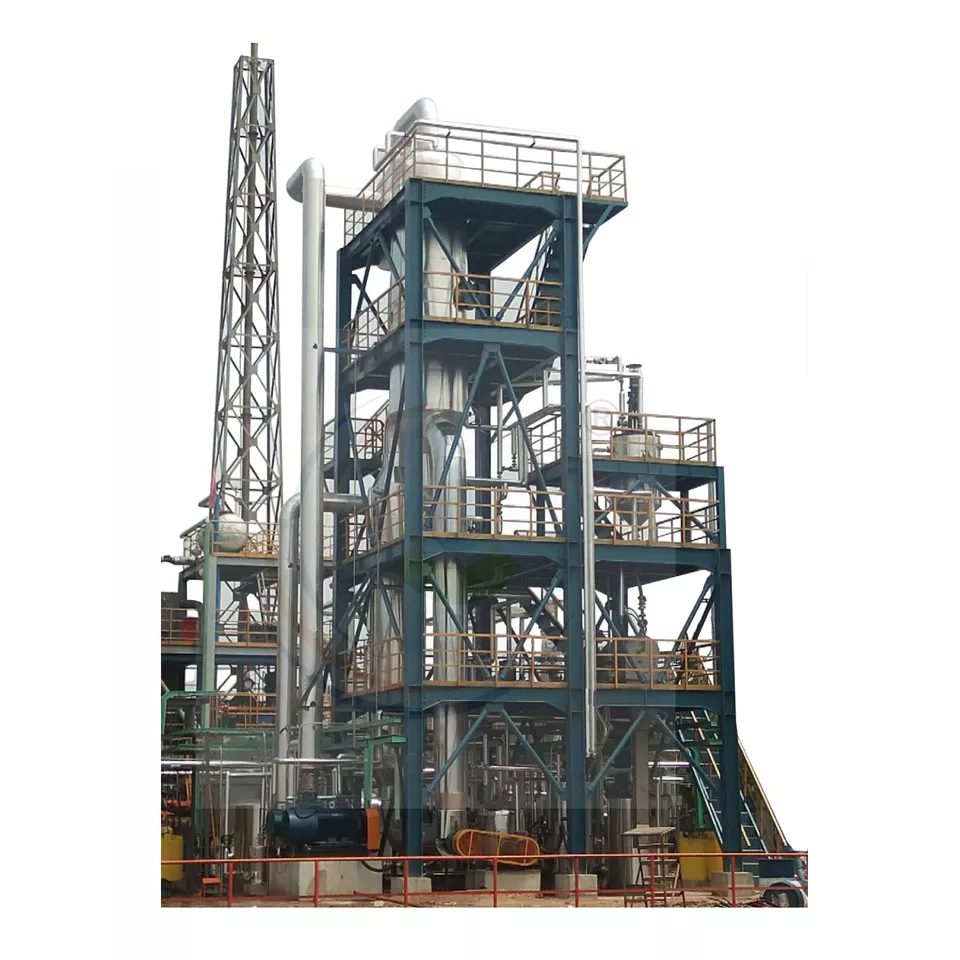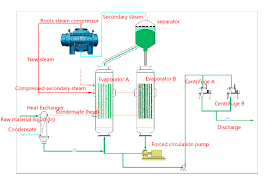what is mvr evaporator ?
View:
Working principle
MVR evaporator is different from ordinary single-effect falling film or multi-effect falling film evaporator, MVR is a single evaporator, integrating multi-effect falling film evaporator, and it adopts segmental evaporation according to the different concentration of products required, that is, when the products cannot reach the required concentration after passing through the effector for the first time, the products will be pumped to the upper part of the effector through the external pipeline of the effector after leaving the effect, and then the products will be pumped to the upper part of the effector through the vacuum pump of the lower part of the effector again. Then, the product is repeatedly passed through the effector to reach the required concentration.

In the process of the product flowing from top to bottom, the product flows in a film shape due to the increase of the area inside the tube, so as to increase the heated area, and the negative pressure is formed inside the effector through the vacuum pump to lower the boiling point of the water in the product, so as to achieve concentration, and the evaporation temperature of the product is about 60℃.
The condensate, part of the steam and the residual steam after the product is heated and evaporated by the effector body are separated together through the separator, and the condensate flows out from the lower part of the separator for preheating the product entering the effector body, and the steam is pressurized through the fan booster (the higher the steam pressure, the higher the temperature), and then the pressurized steam passes through the effector body again through the pipeline and converges with the steam once again.
When the equipment is started, a portion of steam is needed for preheating, and after normal operation, the steam required is significantly reduced. In the process of pressurizing the secondary steam by the fan booster, the electrical energy is converted into the heat energy of steam, so the steam required during the operation of the equipment is reduced, while the electricity required is significantly increased.
The temperature of the product is always about 60℃ during the whole process of flowing in the effect body, and the temperature difference between the heating steam and the product is kept at about 5-8℃. The smaller the temperature difference between the product and the heating medium, the better it is to protect the product quality and effectively prevent the paste tube.
When the concentration of the product is about 50%, only the MVR evaporator can be completed, and when the required concentration is 60%, flash evaporation equipment needs to be installed.
Compression reasons
Reasons for mechanical vapor recompression
Low energy consumption per unit
▪ Low temperature difference makes the evaporation of the product mild
▪ Short product residence time due to common single effect
▪ Simple process and high practicality
▪ Excellent part-load operation characteristics
▪ Low operating costs

Mechanical Vapor Recompressors - Design and Functional Range
Machines for gas compression are operated according to the positive displacement principle or kinetic principle. In a positive-displacement machine, the moving parts of the machine to separate the suction chamber from the pressure chamber, and the volume of the operating chamber are reduced while the gas pressure is increased. In the case of reciprocating compressors, such a process is achieved by the movement of the piston in the cylinder. In a powered machine, the gas energy is supplied by the high circumferential rotation of the impeller blades. The gas is first accelerated and then decelerated through a diffuser located downstream of the impeller. In this way, the high velocity is converted into pressure energy. Depending on the direction of fluid passage through the impeller, the relevant equipment is referred to as axial, mixed-flow or centrifugal compressor. The most suitable type of compressor depends on the operating conditions of the application in question. The key parameters are the pressure rise to be achieved and the flow rate of the vapor to be compressed. Π is the ratio of the final pressure p2 to the suction pressure p1, defined as the compression ratio. Since evaporative units are often operated in the vacuum range, with medium heating surface loads and small temperature differences, centrifugal re-compressors are usually used.
Power operated compressors
Mixed-flow centrifugal
Centrifugal fan
single-stage centrifugal compressors
Multi-stage centrifugal compressors
Technical features
1) low energy consumption and low operating costs.
2) Small footprint.
3)Less supporting public works, less total project investment.
4) smooth operation and high degree of automation.
5) no need for virgin steam.
6) short product residence time due to the common use of single effect
(7) simple process, strong practicality, part-load operation characteristics of excellent
8)Low operating cost, can be evaporated below 40℃ without refrigeration equipment, especially suitable for heat-sensitive materials.
Application scope
1)Evaporation and concentration
2)Evaporation crystallization
3)Low temperature evaporation
1)Evaporation of one ton of water requires electricity consumption of 23-70 degrees of electricity.
2)It can realize low temperature evaporation with evaporation temperature of 17-40℃, without chilled water system.
Basic principle
MVR evaporator, is the abbreviation of mechanical vapor recompression. mvr is a technology that reuses the energy of secondary steam produced by itself, thus reducing the need for external energy.
The secondary steam, after compressing by the compressor, the pressure and temperature can be increased, and the enthalpy increases, which is sent to the heating chamber of the evaporator as heating steam, i.e. raw steam, to maintain the evaporating state of the material, and the heating steam itself will transfer the heat to the material itself to condense into water. In this way, the original steam to be discarded will be fully utilized, recovering the latent heat, and improve the thermal efficiency.
As early as the 1960s, Germany and France have successfully applied this technology in the chemical, pharmaceutical, paper, sewage treatment, seawater desalination and other industries.
Its working process is the low-temperature level of steam compressed by the compressor, the temperature and pressure increase, the enthalpy increases, and then into the heat exchanger condensation, in order to make full use of the latent heat of steam. Except for start-up, no raw steam is needed in the whole evaporation process.
Multi-effect evaporation process, the evaporator of an effect of the secondary steam can not be used directly as the heat source of this effect, only as the second effect or the next few effects of the heat source. Such as the effect of the heat source must be given additional energy, so that its temperature (pressure) increase. Steam injection pump can only compress part of the secondary steam, while mvr evaporator can compress all the secondary steam in the evaporator.
The solution is circulated in a falling film evaporator through a material circulation pump in a heating tube. The initial steam is heated with fresh steam outside the tube to give heat, and the solution is heated and boiled to produce secondary steam, and the secondary steam produced is sucked in by turbo booster fan, and after being pressurized, the temperature of secondary steam is increased and circulated into the heating chamber for evaporation as a heating heat source. After normal start, the turbo compressor will suck in the secondary vapor and turn it into heating vapor after booster, and thus the cycle of evaporation will be carried out continuously. The evaporated water is eventually discharged as condensate.
For cost reasons, single-stage centrifugal compressors and high-pressure fans are commonly used in mechanical steam recompression systems. Therefore, the following description is for such designs. Centrifugal compressors are volume-controlled machines, i.e., the volumetric flow rate remains almost constant regardless of the suction pressure. The mass flow rate, on the other hand, varies proportionally to the absolute suction pressure.
The compression cycle of a single-stage centrifugal compressor is depicted in the enthalpy-entropy diagram. Power required for a single-stage centrifugal compressor.
Example: Compression of saturated water vapor from the evaporator from the suction state p1= 1.9 bar, t1= 119 °C to p2= 2.7 bar, t2= 161 °C (compression ratio Π= 1.4). The compression cycle follows the multivariable curves 1-2, with an increase in the specific enthalpy of steam Δhp. For the specific enthalpy of steam h2, by the equation of the efficiency within the compressor (isentropic efficiency): at this temperature, it enters the heater of the evaporator. Based on the amount of steam being drawn in, kg/hr. The Unit multivariable (effective) compression work, kJ/kg. The Unit isentropic compression work, kJ/kg.
The isentropic efficiency (internal efficiency) of the compressor depends, among other factors, on the multiparty index κ and the molar mass M of the drawn gas, as well as on the drawn temperature and the required pressure rise. For the actual coupled power of the prime mover (electric motor, gas engine, turbine, etc.), a larger margin of mechanical losses is considered. A single-stage centrifugal compressor with an impeller made of standard materials is capable of obtaining a water vapor pressure rise with a compression factor of 1.8, and with higher quality materials such as titanium, the compression factor can be as high as 2.5. In this way, the final pressure p2 is 1.8 times the suction pressure p1, or a maximum of 2.5 times, which corresponds to a saturated steam temperature rise of about 12-18 K, with a maximum temperature rise of up to 30 K, depending on the suction pressure. In the case of evaporation technology, it is common practice to express the pressure of water according to its corresponding boiling point temperature. In this way, the effective temperature difference is directly expressed.
Principle of mechanical vapor recompression
The evaporation equipment is compact and has a small footprint and requires less space. Cooling system can also be eliminated. For the existing plants that need to expand evaporation equipment and supply steam, water supply capacity is insufficient, and the site is not enough, especially the low temperature evaporation needs chilled water condensation, it can receive both save investment and achieve better energy-saving effect.
